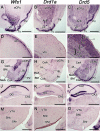Wfs1 is expressed in dopaminoceptive regions of the amniote brain and modulates levels of D1-like receptors
- PMID: 28267787
- PMCID: PMC5436468
- DOI: 10.1371/journal.pone.0172825
Wfs1 is expressed in dopaminoceptive regions of the amniote brain and modulates levels of D1-like receptors
Abstract
During amniote evolution, the construction of the forebrain has diverged across different lineages, and accompanying the structural changes, functional diversification of the homologous brain regions has occurred. This can be assessed by studying the expression patterns of marker genes that are relevant in particular functional circuits. In all vertebrates, the dopaminergic system is responsible for the behavioral responses to environmental stimuli. Here we show that the brain regions that receive dopaminergic input through dopamine receptor D1 are relatively conserved, but with some important variations between three evolutionarily distant vertebrate lines-house mouse (Mus musculus), domestic chick (Gallus gallus domesticus) / common quail (Coturnix coturnix) and red-eared slider turtle (Trachemys scripta). Moreover, we find that in almost all instances, those brain regions expressing D1-like dopamine receptor genes also express Wfs1. Wfs1 has been studied primarily in the pancreas, where it regulates the endoplasmic reticulum (ER) stress response, cellular Ca2+ homeostasis, and insulin production and secretion. Using radioligand binding assays in wild type and Wfs1-/- mouse brains, we show that the number of binding sites of D1-like dopamine receptors is increased in the hippocampus of the mutant mice. We propose that the functional link between Wfs1 and D1-like dopamine receptors is evolutionarily conserved and plays an important role in adjusting behavioral reactions to environmental stimuli.
Conflict of interest statement
Figures









References
MeSH terms
Substances
LinkOut - more resources
Full Text Sources
Other Literature Sources
Molecular Biology Databases
Miscellaneous

